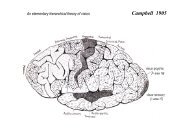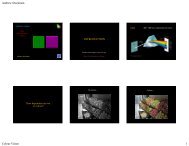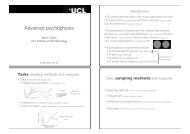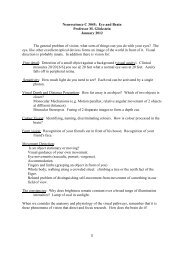Slow and fast pathways in the human rod visual system - CVRL main
Slow and fast pathways in the human rod visual system - CVRL main
Slow and fast pathways in the human rod visual system - CVRL main
You also want an ePaper? Increase the reach of your titles
YUMPU automatically turns print PDFs into web optimized ePapers that Google loves.
1660 J. Opt. Soc. Am. A/Vol. 8, No. 10/October 1991curve would be expected to be cont<strong>in</strong>uous <strong>in</strong> shape. S<strong>in</strong>cethis <strong>in</strong>flection occurs more than 1.5 logi 0 units below conethreshold <strong>in</strong> <strong>the</strong> normal observer <strong>and</strong> s<strong>in</strong>ce it is also found<strong>in</strong> <strong>the</strong> achromat, it cannot simply reflect a transition from<strong>rod</strong> to cone vision.At 15 Hz, <strong>the</strong> data are more clearly <strong>in</strong>compatible withdetection by a unitary mechanism: Not only is <strong>the</strong>threshold curve dist<strong>in</strong>ctly double branched but adjacent toit lies a region (shown here enclosed by dashed l<strong>in</strong>es)with<strong>in</strong> which <strong>the</strong> 15-Hz flicker is completely <strong>in</strong>visible to<strong>the</strong> observer. We attribute <strong>the</strong> double branch <strong>and</strong> <strong>the</strong> disappearanceof flicker to a duality with<strong>in</strong> <strong>the</strong> <strong>rod</strong> <strong>visual</strong>pathway. These features are found at 15 Hz because it is<strong>the</strong> frequency at which <strong>the</strong> signals transmitted through<strong>the</strong> two <strong>pathways</strong> emerge out of phase <strong>and</strong> so destructively<strong>in</strong>terfere. At o<strong>the</strong>r frequencies <strong>the</strong> two signals do notemerge out of phase. At 8 Hz, for example, <strong>the</strong> two differ<strong>in</strong> phase by less than a quarter-cycle (see Ref. 1 <strong>and</strong> seeFig. 4 below).We should note that <strong>the</strong>re is not a simple correspondencebetween <strong>the</strong> two branches <strong>in</strong> <strong>the</strong> 15-Hz thresholddata <strong>and</strong> <strong>the</strong> two <strong>rod</strong> <strong>pathways</strong>. Accord<strong>in</strong>g to our model,much of <strong>the</strong> double-branched curve reflects an <strong>in</strong>teractionbetween <strong>the</strong> slow <strong>and</strong> <strong>the</strong> <strong>fast</strong> <strong>rod</strong> flicker signals; for <strong>in</strong>stance,<strong>the</strong> steeply ascend<strong>in</strong>g portion of <strong>the</strong> curve <strong>and</strong> <strong>the</strong>early portion of <strong>the</strong> upper branch reflect cancellation between<strong>the</strong> two signals. In addition, <strong>the</strong> disappearance of<strong>the</strong> lower threshold <strong>and</strong> <strong>the</strong> lower limit of <strong>the</strong> null above-1.0 logl, scot. Td does not imply that <strong>the</strong> slow <strong>rod</strong> signalis absent at <strong>the</strong>se levels. Ra<strong>the</strong>r, it means that <strong>the</strong> slower<strong>rod</strong> signal is canceled by <strong>the</strong> <strong>fast</strong>er signal, so that it nolonger exceeds threshold.As did o<strong>the</strong>r researchers," 9 we use <strong>the</strong> traditionalthreshold-versus-<strong>in</strong>tensity format <strong>in</strong> which to display ourpsychophysical 8- <strong>and</strong> 15-Hz <strong>rod</strong> flicker detection data; <strong>in</strong>o<strong>the</strong>r words we plot <strong>the</strong> scotopic lum<strong>in</strong>ance of <strong>the</strong> flicker<strong>in</strong>ggreen test light as a function of <strong>the</strong> lum<strong>in</strong>ance of <strong>the</strong>red background field. It should be noted, however, that,because <strong>the</strong> null near 15 Hz is significantly above <strong>the</strong> scotopicflicker threshold, <strong>the</strong> test lights used to p<strong>rod</strong>uce itare <strong>the</strong>mselves moderately <strong>in</strong>tense scotopic adapt<strong>in</strong>g stimuli.To <strong>the</strong> extent that <strong>the</strong> <strong>rod</strong>s adapt <strong>in</strong>dependently of<strong>the</strong> cones, <strong>the</strong> red background field should have little effecton ei<strong>the</strong>r <strong>the</strong> upper or <strong>the</strong> lower limits of <strong>the</strong> null untilits scotopic lum<strong>in</strong>ance exceeds <strong>the</strong> mean lum<strong>in</strong>ance of <strong>the</strong>test lights.B. Electroret<strong>in</strong>ographic DataThe left-h<strong>and</strong> panels of Fig. 2 show ERG results obta<strong>in</strong>edat 8 Hz (upper left) <strong>and</strong> 15 Hz (lower left) for <strong>the</strong> samenormal observer, LTS. The correspondence between <strong>the</strong>mean scotopic ERG ret<strong>in</strong>al illum<strong>in</strong>ances <strong>and</strong> <strong>the</strong> meanpsychophysical ret<strong>in</strong>al illum<strong>in</strong>ances (discount<strong>in</strong>g <strong>the</strong> redbackground) is <strong>in</strong>dicated by <strong>the</strong> arrows. The lowestflashes (for which we show ERG traces <strong>in</strong> Fig. 2) wereapproximately -0.9 logi 0 scot. Td, which is approximately1.8 logl 0 units above <strong>the</strong> absolute threshold for see<strong>in</strong>gGanzfeld 15-Hz flicker <strong>in</strong> <strong>the</strong> ERG apparatus (-2.75logl 0 scot. Td). The flashes were <strong>in</strong>creased <strong>in</strong> steps ofapproximately 0.3 logi 0 unit, as <strong>in</strong>dicated by <strong>the</strong> positionof arrows along <strong>the</strong> ord<strong>in</strong>ate of <strong>the</strong> right-h<strong>and</strong> figures.The 8-Hz ERG data, like <strong>the</strong> psychophysical data, arecomparatively uncomplicated. As <strong>the</strong> flicker amplitudeStockman et al.<strong>in</strong>creases, <strong>the</strong> ERG responses speed up (<strong>the</strong> peaks moveleftward) <strong>and</strong> grow progressively <strong>in</strong> strength. There isno evidence of a null <strong>in</strong> <strong>the</strong>se data at 8 Hz. Once aga<strong>in</strong>,this is not <strong>the</strong> case at 15 Hz: As flicker amplitude <strong>in</strong>creases,<strong>the</strong> amplitude of <strong>the</strong> ERG decl<strong>in</strong>es until a m<strong>in</strong>imumis reached at a ret<strong>in</strong>al illum<strong>in</strong>ance associated with<strong>the</strong> perceptual null <strong>and</strong> <strong>the</strong>n <strong>in</strong>creases above <strong>the</strong> null.(The ret<strong>in</strong>al illum<strong>in</strong>ance correspond<strong>in</strong>g to <strong>the</strong> center of<strong>the</strong> psychophysical null <strong>and</strong> to <strong>the</strong> dim<strong>in</strong>ution of <strong>the</strong> ERGresponse at 15 Hz is approximately -0.3 log 0 scot. Td.)Fur<strong>the</strong>rmore, as <strong>the</strong> ret<strong>in</strong>al illum<strong>in</strong>ance associated withnull is crossed, <strong>the</strong>re is an abrupt reversal <strong>in</strong> <strong>the</strong> phaseof <strong>the</strong> ERG response (i.e., <strong>the</strong> peaks become troughs<strong>and</strong> vice versa). This reversal is <strong>in</strong> accord with our selfcancellationmodel, which predicts a phase difference ofhalf a cycle between <strong>the</strong> slow 15-Hz <strong>rod</strong> signals that predom<strong>in</strong>atebelow <strong>the</strong> null <strong>and</strong> <strong>the</strong> <strong>fast</strong> 15-Hz <strong>rod</strong> signalsthat predom<strong>in</strong>ate above it. These results have been confirmed<strong>in</strong> two o<strong>the</strong>r normal subjects. (Our observers tendto differ slightly as to <strong>the</strong> best frequency for elicit<strong>in</strong>g <strong>the</strong>null <strong>in</strong> <strong>the</strong> psychophysical <strong>and</strong> ERG data, but <strong>the</strong> optimalfrequency is always <strong>in</strong> <strong>the</strong> range 14-16 Hz.)In <strong>the</strong> electrophysiological experiments Ganzfeld flickerwas used, whereas <strong>in</strong> <strong>the</strong> psychophysical experimentssmaller flicker<strong>in</strong>g fields were used. Never<strong>the</strong>less, forboth conditions, <strong>the</strong> subject reported a clear region ofnulled or reduced flicker at 15 Hz. With <strong>the</strong> Ganzfeld,though, <strong>the</strong> null was less uniform <strong>and</strong> could be disturbedmore easily by eye movements. In <strong>the</strong> ERG experimentwe asked <strong>the</strong> normal subject to rate <strong>the</strong> magnitude of <strong>the</strong>perceived flicker. The rat<strong>in</strong>gs for 15-Hz flicker, <strong>in</strong> ascend<strong>in</strong>gorder of <strong>the</strong> stimulus ret<strong>in</strong>al illum<strong>in</strong>ances shown<strong>in</strong> <strong>the</strong> left-h<strong>and</strong> panel of Fig. 2, were as follows: 5, 4, 0, 2,4, 6, <strong>and</strong> 8, with flicker at <strong>the</strong> lowest ERG ret<strong>in</strong>al illum<strong>in</strong>ancebe<strong>in</strong>g def<strong>in</strong>ed as 5. These perceptual rat<strong>in</strong>gs correlateroughly with <strong>the</strong> change <strong>in</strong> <strong>the</strong> amplitude of <strong>the</strong>ERG record<strong>in</strong>gs. Importantly, <strong>the</strong>y show that a reduction<strong>in</strong> <strong>the</strong> perceived flicker or a flicker null can be obta<strong>in</strong>edwith white full-field flicker just as it can with a green,6° test field <strong>and</strong> at comparable ret<strong>in</strong>al illum<strong>in</strong>ances. But<strong>the</strong> rat<strong>in</strong>gs correspond only approximately to <strong>the</strong> amplitudesof <strong>the</strong> ERG records: For <strong>in</strong>stance, <strong>the</strong> observertended to give higher phenomenological flicker rat<strong>in</strong>gs to<strong>the</strong> two flash levels below <strong>the</strong> perceptual null than to <strong>the</strong>two above <strong>the</strong> perceptual null, though <strong>the</strong> latter havegreater peak amplitudes. This discrepancy, however,may reflect <strong>the</strong> fact that different <strong>pathways</strong> predom<strong>in</strong>atebelow <strong>and</strong> above <strong>the</strong> null.C. Control for Cone IntrusionBoth <strong>the</strong> double branch <strong>and</strong> <strong>the</strong> null region found <strong>in</strong> <strong>the</strong>15-Hz data occur at ret<strong>in</strong>al illum<strong>in</strong>ances that are belowcone threshold (Fig. 2, lower-right-h<strong>and</strong> panel, opencircles), suggest<strong>in</strong>g that <strong>rod</strong>s are pr<strong>in</strong>cipally responsiblefor those phenomena. O<strong>the</strong>r psychophysical controlexperiments support this conclusion. 8 9 Rod isolation for<strong>the</strong> full-field white flicker used <strong>in</strong> <strong>the</strong> ERG experiment isless secure, however. As a control we measured 15-HzERG responses <strong>in</strong> <strong>the</strong> normal trichromatic observer LTSbefore <strong>and</strong> after a <strong>rod</strong> bleach. These are shown <strong>in</strong> Fig. 3.As <strong>in</strong> Fig. 2 (lower-left-h<strong>and</strong> panel), <strong>the</strong> left-h<strong>and</strong> panel<strong>in</strong> Fig. 3 shows 15-Hz ERG records made at a series ofret<strong>in</strong>al illum<strong>in</strong>ances, <strong>in</strong> this case separated by steps of










